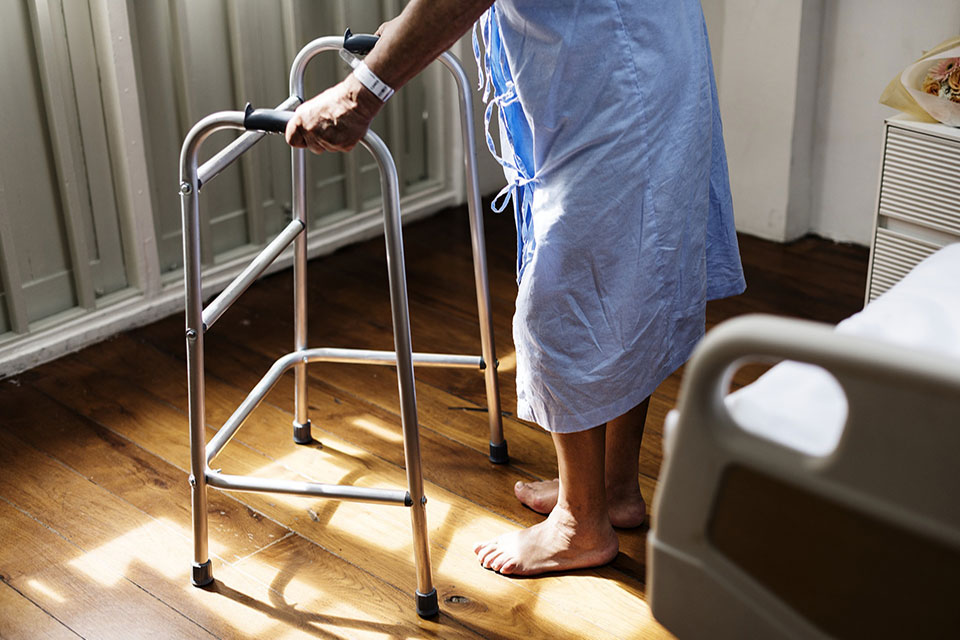Lamy Center Caregiver Connection: Falls Prevention for Caregivers
Written By: Rudi Lamy, MLS, MAS, Consultant to the Peter Lamy Center on Drug Therapy and Aging
The wonderful writer Shel Silverstein begins his poem “Falling Up” like this: “I tripped on my shoelace and I fell up.” But when you are caring for an elderly family member, a person with dementia, or both, falling up is not what you need to concern yourself with. You need to be concerned about falling down, and the various causes and outcomes of such a fall — serious or not.
Our Latest Falls
I’ve been caring for my wife for more than 10 years now. In that time, we’ve both taken our fair share of tumbles. My latest was caused by a series of poor decisions — the wrong shoes, wrong time of day, and the wrong weather landed me flat on my back on the asphalt. My wife’s most recent fall occurred in the bathroom. She fell awkwardly and was trapped between the wall and toilet, with her body blocking the door. I could not push it open without hurting her. I called 911, and the EMTs who arrived decided the only way to extricate my wife was to cut the door in two.
There is an old axiom that says it’s not the fall that kills you, it’s the sudden stop at the bottom. Having helped my wife recover from previous falls, I’ve learned that even the act falling often brings a number of physical, psychological, and emotional consequences which may include:
- Fractures
- A constant fear, even terror, of falling again
- A fear of returning to the place where the fall occurred (my wife now stands frozen in place when entering the bathroom)
Falling: How Can I Help My Loved One?
There are a number of reasons that people fall. When you are caring for someone, you must consider his or her:
- Age
- Physical fitness and general health
- Type and severity of dementia (if applicable)
- Prescription and over-the-counter medications and possible interactions
“One in three older Americans fall each year, but there are some steps patients and their caregivers can take to help prevent falls,” says Nicole Brandt, PharmD, MBA, BCPP, CGP, FASCP, professor in the Department of Pharmacy Practice and Science (PPS) and executive director of the Peter Lamy Center on Drug Therapy and Aging at the School of Pharmacy. “I recommend that all older adult patients and their caregivers talk to their health care team about their individual fall risks, especially to review any medications that they might be taking that could increase their risk for falls. Caregivers can also visit the Lamy Center’s website, where there are a number of downloadable brochures and resources that offer tips to help reduce home hazards and implement lifestyle changes that can decrease their loved one’s risk for falls.”
How the Pros Do It
Health care professionals use a variety of tools and methods to evaluate their patients’ risk for falls. Even a quick Google search for “geriatric falls assessment” will return more than 29 million results. The geriatric unit that assesses falls at Sheppard Pratt uses the following scale:
In contrast, the last time my wife was in the emergency room at a local teaching hospital, the health care professionals assessed her fall risk by having an ER physician and nurse observe her as she walked back and forth in her room.
Caregivers Are Not Health Care Professionals
Many caregivers do not have the knowledge or training necessary to professionally evaluate their loved one’s falls risk. We do, however, have our experiences and the experiences of our peers to help us make an informed judgment as to when we should consult our health care team about this risk.
We also have resources we can use to assist us in our labor of love, such as the falls prevention advice offered on the National Council on Aging’s “Preventing Falls: Tips for Older Adults & Caregivers” website and Merck Manual’s “Falls in the Elderly,” as well as the falls materials available through the Maryland Department of Aging. The Baltimore County Department of Aging, as well as other county offices on aging, have a program called Stepping On: Fall Prevention Education.
The Caregiver as Active, Reactive, or Inactive
A true caregiver must never be inactive when it comes to caring for his or her loved one. However, as a caregiver, I have been exceptionally reactive. My wife falls, I immediately react to help. Our bathtub is now a shower stall with three grab bars, a bath mat, and a shower chair with a back. There are arms on the toilet, and we got a nice new Dutch door to replace the old one that had been bisected. This door has no lock. We also installed a grab bar on the wall directly in front of the toilet. Another time, after she fell out of bed, I got a bed rail. But, everything I did was done after the fact.
Let’s begin to be proactive together. Do you have any experience helping an older loved one recover from a fall? Are there any resources that you have used to help prevent falls for a person for whom you have been caring? Share your thoughts with me by leaving a comment below.
Thanks for reading.
Thanks for caring.
Rudi Lamy
Caregiver



Rudi-
Thank you for your support and caring through your posts. It means a great deal to the Lamy Center
Best, Nicole Brandt, PharmD, MBA
This is an excellent post.
Thanks for sharing,
Martha
Lots of practical advice, and it was reinforced by your wise practical experience vignettes woven into the article.
Congrats!
Ken